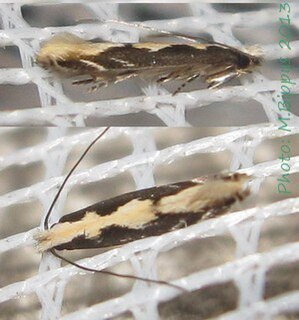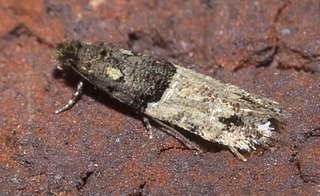| Opogona omoscopa | |
|---|---|
 | |
| Scientific classification | |
| Kingdom: | Animalia |
| Phylum: | Arthropoda |
| Class: | Insecta |
| Order: | Lepidoptera |
| Family: | Tineidae |
| Genus: | Opogona |
| Species: | O. omoscopa |
| Binomial name | |
| Opogona omoscopa (Meyrick, 1893) | |
| Synonyms | |
| |
| Opogona omoscopa | |
|---|---|
 | |
| Scientific classification | |
| Kingdom: | Animalia |
| Phylum: | Arthropoda |
| Class: | Insecta |
| Order: | Lepidoptera |
| Family: | Tineidae |
| Genus: | Opogona |
| Species: | O. omoscopa |
| Binomial name | |
| Opogona omoscopa (Meyrick, 1893) | |
| Synonyms | |
| |
It is found in western Australia, New Zealand, south-east Asia, in Africa from Ethiopia to South Africa and several islands of the Indian Ocean. [1] It is also one of the few species that had been recorded on the remote island of Île Amsterdam of the French Southern and Antarctic Territories. It is an introduced species in the United States, Europe and the United Kingdom.
The wingspan is about 18-22 mm. [2]
The larvae feed on various types of decaying vegetation including rotting wood, cork, compost, rhubarb, gladioli corms and pineapple roots. Host-plants include: Persea sp. (Lauraceae), Limonium sp. (Plumbaginaceae), Cyclamen sp. (Myrsinaceae), Thuja sp. (Cupressaceae), Fuchsia sp. (Onagraceae), Saccharum sp. (Poaceae) and Quercus suber (Fagaceae). [3]
Acridotarsa is a genus of moths belonging to the family Tineidae. The genus was described by Edward Meyrick in 1893.
Paraptica is a genus of moths belonging to the family Tineidae.

Tiquadra is a genus of moths belonging to the family Tineidae.

Amphixystis is a genus of moths belonging to the family Tineidae. The family was first described by Edward Meyrick in 1901.

Opogona is a genus of the fungus moth family, Tineidae. Therein, it belongs to the subfamily Hieroxestinae. As it includes Opogona omoscopa, the type species of the now-abolished genus Hieroxestis, it is the type genus of its subfamily.
Scalmatica is a genus of moths belonging to the family Tineidae.
Stemagoris is a genus of moths belonging to the family Tineidae.
Lysitona is a genus of moths belonging to the family Tineidae. As of 2018, it contains only one species, Lysitona euryacta, which is found in Mozambique.

Opogona dimidiatella is a moth of the family Tineidae. It is found in southern South Africa, Kenia, Uganda, Réunion, India, Indonesia (Java), Sri Lanka and the Philippines.

Erechthias dracaenura is a moth of the family Tineidae. It is endemic to São Tomé Island, an island off the western equatorial coast of Central Africa. The species was described by Edward Meyrick in 1934.
Opogona amphichorda is a moth of the family Tineidae. It was described by Edward Meyrick in 1921 and is found in Congo and in Mozambique. This species has a wingspan of 10–13 millimetres (0.39–0.51 in). Its forewings are pale ochreous-yellowish with a dark fuscous pointed streak along basal fourth of the costa.
Opogona autogama is a moth of the family Tineidae.

Uromycladium tepperianum is a rust fungus that infects over 100 species of Acacia and related genera including Paraserianthes in Australia, south-east Asia, the south Pacific and New Zealand. The acacia gall rust fungus species Uromycladium tepperianum has been introduced to South Africa as a biological control on the invasive Australian shrub Acacia saligna.

Oenoe is a genus of moths belonging to the family Tineidae.

The Hieroxestinae are a subfamily of moths of the family Tineidae.
Cosmetra spiculifera is a species of moth of the family Tortricidae first described by Edward Meyrick in 1913. It is found in the Democratic Republic of the Congo, Cameroon, South Africa, Gabon, Ghana, Réunion, Mauritius and Nigeria.